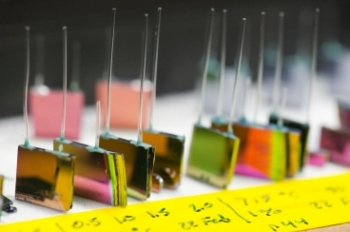Researchers at Massachusetts Institute of Technology (MIT) have designed a new photovoltaic energy-conversion system using a material whose surface is etched with billions of nanoscale pits that help the surface to emit light energy with wavelengths suitable for optimum electricity production by the system.
 Different silicon chip micro-reactors devolped by the MIT research team
Different silicon chip micro-reactors devolped by the MIT research team
The heat source for the material could be the sun, a decaying radioisotope or a hydrocarbon fuel. The button-sized power generator, which utilizes propane or butane as its heat source, is called as micro-thermophotovoltaics (TPV) power generator. Warren K. Lewis and Klavs Jensen of Chemical Engineering designed the power generator’s vital part called micro-reactor and the generator is developed in the Microsystems Technology Laboratories.
Ivan Celanovic, a research engineer of the Institute for Soldier Nanotechnologies (ISN) at MIT, stated that the solution to develop the TPV generator is to engineer a thermal emitter that emits only particular wavelengths suitable for the PV diode to produce optimum electricity, while repressing other wavelengths. The innovative material can be developed by producing a photonic crystal using a sample of material and creating certain nanoscale patterns such as ridges and holes on its surface. The resulting material allows the propagation of light in a different manner.
According to Marin Soljaèiæ, ISN researcher and professor of physics, materials with unique optical properties can be fabricated by selecting the design of the nanostructure. The resulting material has the capability to manipulate and control the light behavior.
The micro-TPV power generator using hydrocarbon fuels as its heat source has an operating life three times more than a lithium-ion battery with the same weight and size. It can be instantaneously recharged by a small cartridge of fresh fuel. The generator that uses radioisotope as its heat source could produce electric power for about three decades with no need for refueling or servicing. This device is suitable for powering spacecrafts committed for long missions.